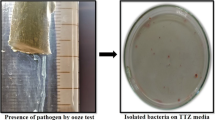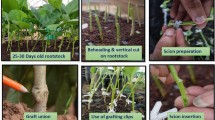Abstract
The potential of grafted watermelon for resistance toFusarium oxysporum f.sp.niveum on some Curcurbitaceae,Lagenaria, Luffa, Benincasa and commercial rootstocks was evaluated. Effects of grafting on yield and quality of diseased plants were evaluated. All grafted plants and rootstocks were resistant to the three known races (0, 1, and 2) ofF. oxysporum f.sp.niveum except watermelon cv. ‘Crimson Tide’, which was susceptible to race 2. Fruit yield was positively (21–112%) affected byLagenaria rootstocks but negatively affected (200–267%) byCucurbita rootstocks when compared with the control. While only minor differences in fruit quality were determined in control and grafted plants onLagenaria rootstocks, the quality parameters for watermelon grafted ontoCucurbita rootstocks were lower than in the control. The reasons for low yield and quality might be due to an incompatibility betweenCucurbita rootstocks and watermelon. These results showed that rootstock influence on disease resistance as well as yield and quality of scion fruit is important in determining the potential use of grafting applications in watermelon.
Similar content being viewed by others
References
Anon. (2001) FAO Statistical Database, http://www.fao.org.com.
Biles, C.I., Martyn, R.D. and Wilson, H.D. (1989) Isozymes and general proteins from various watermelon cultivars and tissue types.HortScience 24:810–812.
Chouka, A.S. and Jebari, H. (1999) Effect of grafting on watermelon on vegetative and root development, production and fruit quality.Acta Hortic. (Wageningen) 492:85–93.
Den Nijs, A.P.M. and Smeets, L. (1987) Analysis of difference in growth of cucumber genotypes under low light conditions in relation to night temperature.Euphytica 36:19–32.
Dubois, M., Gilles, K.A., Hamilton, J.K., Rebers, P.A. and Smith, F. (1956) Colorometric method for determination of sugar and related substances.Anal. Chem. 28:350–356.
Edelstein, M., Cohen, R., Burger, Y. and Shriber, S. (1999) Integrated management of sudden wilt in melons, caused byMonosoporascus cannonballus, using grafting and reduced rates of methyl bromide.Plant Dis. 83:1442–1445.
Gindrat, D., Ducrot, V. and Cacia, R. (1977) Varietal resistance and grafting: Two methods of preventive control for tomato Fusarium wilt.Hortic. Abstr. 1978 (48):1499.
Ito, T. (1991) Present state of transplant production practices in Japanese Horticultural Industry.in: Kurata, K. and Kozai, T. [Eds.] Transplant Production System. Kluwer Academic Publ., Yokohoma, Japan. pp. 65–82.
Kato, N. and Ogiwara, S. (1978) Studies on the properties of the growth, the nutrient uptake and photosynthesis of the grafted melons.Bull. Chiba Agric. Exp. Stn. 21:119–129.
Kato, T. and Lou, H. (1989) Effect of rootstocks on yield, mineral nutrition and hormonal level in xylem sap in eggplant.J. Jpn. Soc. Hortic. Sci. 58:345–352.
Kurt, S., Baran, B., Sari, N. and Yetisir, H. (2002) Physiologic races ofFusarium oxysporum f.sp.melonis in the southeastern Anatolia Region of Turkey and varietal reaction to races of the pathogen.Phytoparasitica 30:395–402.
Lecoq, H., Blancard, D., Nicot, F., Glandard, A., Molot, P.M. and Mas, P. (1991) Techniques d’Inoculation Artificielle du Melon avec Différents Agents Pathogénes pour la Séléction de Variétés Résistantes. INRA, Montfavet, France.
Lee, J.M. (1994) Cultivation of grafted vegetables I. Current status, grafting methods and benefits.HortScience 29:235–239.
Leoni, S., Grudina, R., Cadinu, M., Madeddu, B. and Carletti, M.G. (1990) The influence of four rootstocks on some melon hybrids and a cultivar in greenhouse.Acta Hortic. (Wageningen) 287:127–134.
McCreight, J.D., Nerson, H. and Grumet, R. (1993) Melon (Cucumis melo L.).in: Kallo, G. and Bergh, B.O. [Eds.] Genetic Improvement of Vegetable Crops. Pergamon Press Ltd., Oxford, UK. pp. 267–283.
Nelson, P.E., Toussoun, T.A., Burgess, L.W., Mararas, W.F.O. and Liddell, C.M. (1986) Isolating, identifying and producing of pathogenic species ofFusarium.in: Kickey, K.D. [Ed.] Methods for Evaluating Pesticides for Control of Plant Pathogens APS Press, St. Paul, MN, USA. pp. 54–59.
Nielsen, G. and Kappel, F. (1996) Bing sweet cherry leaf nutrition is affected by rootstocks.HortScience 31:1169–1172.
Oda, M. (1995) New grafting methods for fruit-bearing vegetables in Japan.Jpn. Agric. Res. Q. 29:187–198.
Rose, A.F. (1959) Dinitrophenol method for reducing sugars.in: Talburt, W.F. [Ed.] Potato Processing. The AVI Publishing Co. Inc., Westport, CT, USA. pp. 469–470.
Ruiz, J.M. and Romero, L. (1999) Nitrogen efficiency and metabolism in grafted melon plants.Sci. Hortic. (Amst.) 81:113–123.
Tachibana, S. (1989) Respiratory response of detached root to lower temperatures in cucumber and figleaf gourd grown at 20°C root temperature.J. Jpn. Soc. Hortic. Sci. 58:333–337.
Yücel, S., Pala, H., Sari, N. and Abak, K. (1998) Determination ofFusarium oxysporum f.sp.niveum in the East Mediterranean region of Turkey and response of some watermelon genotypes to the disease.Turkish VIII Phytopathology Congr. (Ankara, Turkey), pp. 14–18.
Zerki, M. and Parsons, L.R. (1992) Salinity tolerance of citrus rootstocks: Effects of sault on root and leaf mineral concentrations.Plant Soil 147:171–181.
Zijstra, S., Groot, S.P.C. and Jansen, J. (1994) Genotypic variation of rootstocks for growth and production in cucumber; possibilities for improving the root system by plant breeding.Sci. Hortic. (Amst.) 56:185–186.
Author information
Authors and Affiliations
Corresponding author
Additional information
http://www.phytoparasitica.org posting Feb. 2, 2003.
Rights and permissions
About this article
Cite this article
Yetışır, H., Sari, N. & Yücel, S. Rootstock resistance to Fusarium wilt and effect on watermelon fruit yield and quality. Phytoparasitica 31, 163–169 (2003). https://doi.org/10.1007/BF02980786
Received:
Revised:
Issue Date:
DOI: https://doi.org/10.1007/BF02980786




